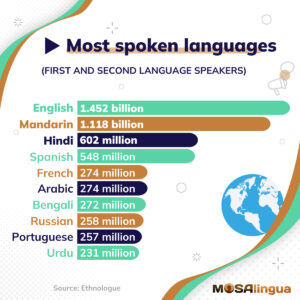Not long ago, we wrote about the ten most-spoken languages in the world as well as some of the more obscure languages. That made us curious about the linguistic diversity that exists around the world. Just how many languages are there? Today we’re exploring the surprisingly large number of languages spoken around the world, what makes them unique, and the ways in which they aren’t so different from each other after all. Plus, find out why the number of languages in the world is actually getting smaller by the day.

How Many Languages Are There?
The fact of the matter is, it’s impossible to determine the exact number of languages in the world. And it’s no wonder when you consider how hard it is to even differentiate between a language and a dialect. Different ways of classifying language leads to different counts. Not to mention that there are remote regions of the world that are hard to access, let alone study from a linguistic point of view.
According to current estimates, there are upwards of 7,000 living languages spoken around the world. The language encyclopedia Ethnologue lists 7,168 in the 2023 edition, to be exact.
But that number is shrinking, not growing.
Statistics show that about half of all languages could become extinct by the end of the 21st century. Based upon the Ethnologue estimate, that’s over 3,500 languages—gone!
Language Fascination
If we imagine that communication exists on a continuum, humans have the most developed system of all living creatures. Language allows us to express our thoughts and to communicate through a wide range of signals (vocal, gestural, graphic, tactile, olfactory, etc.). It is also the result of social acquisition.
Language is how cultures express themselves, so each one should be celebrated for its unique characteristics!
Languages are living things, and as a result, they are subject to external phenomena and variation. Generally speaking, a language is born, lives, evolves, and perhaps dies. A language dies along with the last member of the social group that spoke it.
The extinction of a language represents the irreversible loss of important knowledge, so linguistic diversity is considered an extremely precious resource.
Language can also be an instrument of cultural adaptation or domination. Imposing a language on a population is essentially an attempt to erase the individuality and expression of their native culture. Colonialism had a devastating effect on the life and vitality of countless indigenous languages.
To use the United States as an example, a large factor in the disappearance of many indigenous tribal languages was the loss of native lands and the prohibition of speaking and passing mother tongues on to younger generations.
Start learning a new language today
What are the most-spoken languages in the world?
As mentioned earlier, you can check out our article about the most-spoken languages around the world if you’d like to learn more.
Here’s a quick look:
It’s not surprising that English is at the top of this list with over 1.4 billion speakers worldwide. Mandarin Chinese comes in at a close second with 1.1 billion, followed by Hindi and Spanish.
Based on these numbers, about a quarter of the world’s population speaks English, Chinese, or Hindi!
What’s the difference between a language and a dialect?
There is no strict definition that differentiates between a language and a dialect.
Often, what sets a language apart from a dialect is the degree of official recognition it receives. This recognition often comes from the government or another dominating power.
In a way, a language is a dialect that has managed to spread and impose itself upon others.
Official status often serves to help stabilize and codify a language, especially its written form, and to guarantee a certain number of speakers. Dialects, on the other hand, are often at a greater risk of losing speakers.
How many language families are there?
For a non-exhaustive list of the different languages spoken around the world, I recommend this Wikipedia article that lists by total number of speakers.
According to Ethnologue, these languages are grouped into 142 linguistic families. Have a look at the map below to visualize where these groups originate.

Here’s a list of some of the largest language families around the world:
- Afro-Asiatic
- Austronesian
- Dravidian
- Indigenous American
- Indo-European
- Kartvelian
- Niger-Congo
- Nilo-Saharan
- Sino-Tibetan
- Trans-New Guinea
- Turkic
Geographic distribution
It’s interesting to note that the spread of certain language groups is far from homogeneous.
It’s estimated that there are over 1,500 different languages and dialects spoken in Africa alone. There are some countries with particularly fascinating cases. Take Cameroon, which comprises 270 dialects across 12 million inhabitants. In Nigeria, there are 300 ethnic groups that speak over 500 different languages!
But these aren’t even the most extreme cases – the people of Papua New Guinea speak 839 languages, which makes this country the most linguistically diverse in the world!
As a continent, Oceania is the most diverse. There are several indigenous groups working to protect their languages.
In other parts of the world, like the United States, colonization and cultural genocide have resulted in greater loss of native tongues, though there are several indigenous tribes who are advocating for recognition and protection of their tribal languages.
At-risk languages
According to a study published by UNESCO, it’s estimated that 43% of languages are in danger of extinction. This translates to about 2,580 languages!
If this subject interests you, here’s an article on the safeguarding of endangered languages.
There are approximately 1,000 languages that have fewer than 1,000 speakers, and more than 300 with less than 100 speakers. 114 languages have 9 or fewer surviving speakers.
Other estimates, cited in this National Geographic piece about vanishing languages, have suggested that one language disappears every two weeks. This doesn’t necessarily mean that the language is definitively erased, as several (Hebrew being one example) have been preserved and revived over the course of history.
Among the threatened today are Cha’palaa, which has fewer than 10,000 speakers in Ecuador, and Walmajarri, which has fewer than 1,000 speakers in Western Australia. There are also extremely urgent cases, like Nuxalk, an Indigenous Canadian language that has three living speakers.
Recap: How Many Languages Are There?
In addition to their important role in communication, languages are a fundamental element of cultural identity. It’s essential that we make an effort to protect and preserve them. Some of the top statistics to remember from this article:
- There are approximately 7,100 different languages spoken around the world.
- About 2,500 languages are endangered.
- Oceania is the continent with the greatest linguistic diversity.






Comments